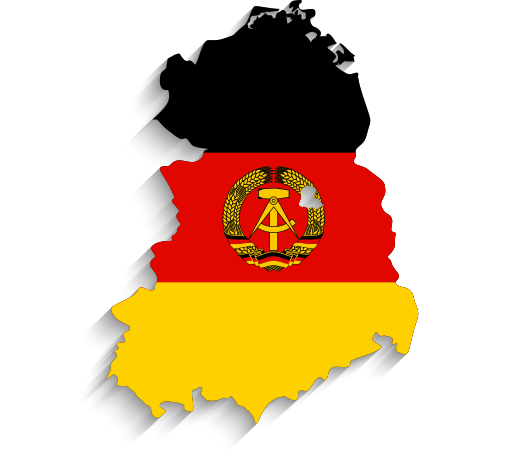(Grant Agreement n. 669194)
Among the European socialist states, East Germany presented several particularities, many of which were direct consequences of the division of Germany. Facing the challenge of the more prosperous Federal Republic of Germany (FRG) next door, the ruling Socialist Unity Party of Germany (Sozialistische Einheitspartei Deutschlands or SED) practised a policy of closed borders and aimed to improve the state’s economic performance. However, in trade with West Germany (intra-German trade) some beneficial bonds persisted.
In the 1960s, the ‘New Economic System’ reform adopted some market elements and an import-led growth strategy. However, the reform retained the concept of a centrally planned economy and did not prove particularly successful. An escalating number of large-scale investments exceeded the economic means of the GDR and increased its indebtedness to the West. Domestic disagreement, together with Soviet dislike, over the reforms and a growing dependency on the West led to the New Economic System being abandoned in 1970/71, and more importantly to a change of party leader: in 1971 Erich Honecker succeeded Walter Ulbricht as First Secretary of the SED.
Nevertheless, the import-led strategy was not abandoned. After gaining international recognition in the early 1970s, East Germany put more effort into diversifying its economic relations with the West, not the least to reduce its dependence on the FRG. In the 1970s, these efforts produced only limited results and were additionally impaired by the progress of West European integration, in particular the European Economic Community’s (EEC) adoption of the Common Commercial Policy. This impaired GDR trade with EEC members other than West Germany, intra-German trade not being subject to the policy. Exclusive EEC competence made technical contacts with the EEC Commission necessary. Nevertheless, the GDR opted for bilateral relations with the EEC members. Despite the resulting problems in day-to-day business, no initiative to change the policy toward the EEC came from the ministries or from foreign trade companies. In 1977, the GDR started to negotiate with the EEC Commission on fisheries but nonetheless stuck with Moscow’s line and refused to recognise the EEC. Despite continually deploring EEC protectionism, over time the East German view of West European integration altered profoundly. First came the academics, who were followed by the officials of the ministries involved (though to different degrees). Somehow, by the late 1970s this new approach made it up to the top of the party: from a capitalist stillbirth the Community had turned into a role model for the Council for Mutual Economic Assistance (CMEA), even in Honecker’s eyes.
In the GDR’s general economic strategy, modernisation through imports had been based on loans and had initially been regarded as a temporary necessity. However, it developed into a permanent strategy. Honecker introduced the ‘Unity of Economic and Social Policy’ concept. This policy was expensive as it included subsidised prices, a housing programme and imports of consumer goods. The East German economy was never able to cover the costs. Immediately, the State Planning Commission (headed by Gerhard Schürer), central and foreign trade bankers (Grete Wittkowski, Helmut Dietrich), Minister of Finance Siegfried Böhm and experts from academia (Helmut Koziolek, Otto Reinhold) warned of the potential consequences of increasing debts. In later years, this chorus was joined by the Ministry of State Security. Apart from the issue of debt, the agency of these economic elite members was less visible than in other CMEA countries. Economic and foreign policy decision-making was monopolised by party leader Honecker and his closest advisors. Honecker’s party-state “small circle” consisted of the Politburo members responsible for economic policy and leading state functionaries, among whom the SED’s economic secretary Günter Mittag was the most notable figure. Critics in the SED leadership (like Werner Krolikowski and Prime Minister Willi Stoph) hardly ever complained openly. Instead, they blackmailed Honecker and Mittag in Moscow. Despite internal warnings and massive Soviet complaints about the GDR’s dependence on the West, the party leadership’s rationale was to keep people satisfied (to the greatest possible extent) and the economic policy remained unchanged. The balance of payments crisis aggravated toward the end of the 1970s. Declining Soviet support and domestic and financial turbulence in other socialist states made the situation even worse. Facing a Western credit boycott, in 1982 many East German economic experts regarded bankruptcy as unavoidable. However, in the short term solvency was secured through several emergency measures. This was primarily achieved by the GDR’s major crisis management body, the Commercial Coordination division (Bereich Kommerzielle Koordinierung or KoKo), headed by Alexander Schalck-Golodkowski. The desired but deceiving financial salvation came in the form of billion Deutschmark loans contrived by Bavarian PM Franz Josef Strauß in 1983/84. This success in surviving a severe economic crisis without fundamentally changing the failed economic policy proved to be only a short-term achievement, and actually contributed to the collapse of the regime in 1989.
* All the texts about the GDR posted here summarise the research findings of PanEur1970s team member Maximilian Graf, which are published as Maximilian Graf, “ Drifting Westward? East Germany and Integrated Europe”, in Angela Romano and Federico Romero (eds), European Socialist Regimes’ Fateful Engagement with the West: National strategies in the long 1970s (Routledge 2020).
